Editor's Note: Contrary to what has been previously claimed on this site—and by many other sources—adding a permanent second valve to the Reynolds bass trombone was not a new or completely original solution. Former Boston Symphony Orchestra bass trombonist Doug Yeo explored the range of historical approaches and solutions to extending the range of the B♭ bass trombone in his 2015 article, "Evolution: The Double-Valve Bass Trombone" for the International Trombone Association Journal, debunking some of the long-held mythology around the Contempora and other popular models.
To grossly summarize, F.E. Olds produced the first B♭ bass trombone with two valves permanently attached in 1938, but it was undersized and never caught on in the professional symphonic world outside of the Los Angeles studios. In 1952, Edward Kleinhammer (Chicago Symphony) had an instrument repairman convert an unspecified bass trombone (Conn 70H?) into a double-valve bass and later worked with Holton on the TR-180. Lawrence Weinman (Minneapolis Symphony) convinced Vincent Bach to make the first prototype of the Bach 50B2 in 1956, using the Olds bass as a reference point. And Kahila, with Ostrander and Counihan, worked with Reynolds in 1957-58 to bring the Contempora double-valve bass to market. While neither first or wholly original, the "Stereophonic" firmly stands in this historical stream of experimentation and innovation.
In the early 1950s, Kauko Kahila — bass trombone, St. Louis Symphony — began correspondence with F.A. Reynolds Co. on more effective ways of extending and playing the low-register range of the bass trombone. With a standard one-valve change to F, the lowest playable chromatic is the low C, leaving a half-step gap to the pedal B♭ — bass trombonists typically had to either "lip down" the C to approximate the B or pull tuning slides out, extending the instrument's length to get close to the desired B, but leaving the horn ill-tuned for other notes until the slides could be readjusted.
Like other manufacturers at the time, Reynolds had accommodated the latter approach by providing an F attachment with an extra-long tuning slide to E on their original Contempora "Symphony" model (1949). However, Kahila (and many others) wanted to more accurately and more easily play passages such as the low B glissando in Bartok’s “Concerto for Orchestra” (written in 1944 and premiered by the Boston Symphony Orchestra, it was a standard piece in the orchestra's repertoire and a recurring challenge for Kahila, having joined Boston in 1952).
Reynolds introduced a new Contempora bass trombone, the “Philharmonic” model, in 1955-56 with a modified F attachment that had two tuning slides: the main F tuning slide for conventional use and a second slide that could pulled to achieve E tuning, then pushed in to return to F. This was an advantage over the conventional “Symphony” model with its single tuning slide, but still required a player to manually adjust a tuning slide while playing.
Kauko Kahila
Bass Trombone, Boston Symphony Orchestra
Allen Ostrander
Bass Trombone, New York Philharmonic Orchestra
Louis Counihan
Bass Trombone, Metropolitan Opera Orchestra
The "Philharmonic" model proved to be popular with orchestral bass trombonists. Kahila selected it as a lighter and more responsive alternative to his traditional Schmidt bass trombone for Boston Pops concerts. Kahila, Allen Ostrander (New York Philharmonic Orchestra) and Louis Counihan (Metropolitan Opera Orchestra) all endorsed the model. Counihan appears in 1956 print ads praising the new model and all three are featured in late 1950s Reynolds catalogs.
According to records in the NYPO digital archives, Ostrander switched from a Conn 70H to the "Philharmonic" model in early 1957, taking it on the orchestra's spring tour that April. His instrument is recorded as serial number 45190, which matches an early 1957 date, and is valued at $395, the same list price in the 1958 catalog.
Not fully satisfied with the solution provided by the "Philharmonic", Kahila continued to experiment with designs that would engage the E tubing only when needed through the press of a trigger and a second rotary valve. He claimed that he came up with the design for the double-valve tubing by laying out strands of string on the floor — this might suggest the origin of the unique “Reynolds wrap” design that extends the F-attachment tubing forward toward the bell in what Doug Yeo calls "a radical change ... and an early example of what we now call 'open wrap'". Kahila sent the designs to Reynolds and they agreed to move forward with a pilot.
As a result of the discussions with Kahila, Reynolds built three prototypes in late 1957 and brought in Ostrander and Counihan for testing and feedback. The three musicians met over the winter of 1957-58 to discuss the prototypes—they requested changes to the placement of braces around the valve section and suggested the use of saxophone-style key rollers to aid the dependent dual-trigger design. Reynolds began work on implementing their recommendations and that fall, after playing the prototype on a summer tour throughout Latin America, Ostrander sent his model back to the factory to be upgraded. Ostrander's instrument was serial number 49479 and valued at $500 (list price in 1958)—unlike Kahila and Counihan's prototypes with the standard Reynolds bronze bell, Ostrander had requested a yellow brass bell.
Commercially introduced in the fall of 1958, the “Stereophonic” Contempora was the first of a new generation of widely available double-valve bass trombones, along with the Bach 50B2 (1961), the Holton TR-180 (1964) and the Conn 73H (1968).
Whereas Kahila seems to have ultimately preferred his single-valve “Philharmonic” bass trombone for daily playing, Ostrander quickly championed the advantages of the “Stereophonic” double-valve design for his NYPO playing and teaching methods. An image of the Reynolds double-valve section appears on the front of my copy of Ostrander’s “Double-Valve Bass Trombone Low Tone Studies” method book. Ostrander also appears to have been somewhat of a gearhead, ordering a second Reynolds horn and mixing and matching bells and valve sections from different manufacturers to see how they played.
Postscript
The "Stereophonic" originally featured attachments that provided F and flat E tuning as this was the simplest way to add the chromatic low C and B notes to the end of the slide. As more double-valve models entered the marketplace in the 1960s, players began to express a preference for F and D attachments, as the latter made it more efficient to play in the low register by placing the B closer in on the slide. Finally, in response to the increasing number of customer requests, the factory superintendent in charge of Engineering and Design at Olds' Fullerton plant (where Reynolds instruments were then made), Zig Kanstul, designed an extension that fit into the existing E attachment tuning slides, lowering the double-valve pitch to D.
A factory-made D extension for the "Stereophonic" Contempora is shown below in the upper left, along with several examples of custom-made extensions that have been spotted "in the wild".
Another customization that some players have made is splitting the dependent trigger paddles so that different fingers operate each one—usually this done for specific ergonomic reasons or if a player is more comfortable with a trigger layout from another instrument.
The purpose of this website is to preserve the history of the F. A. Reynolds Company and the distinctive qualities of its brass instruments. Contempora Corner and contemporacorner.com are not related or associated in any way to the former or current F.A. Reynolds Company.
Copyright © 2004-2024 ElShaddai Edwards. All Rights Reserved. Terms of Use.

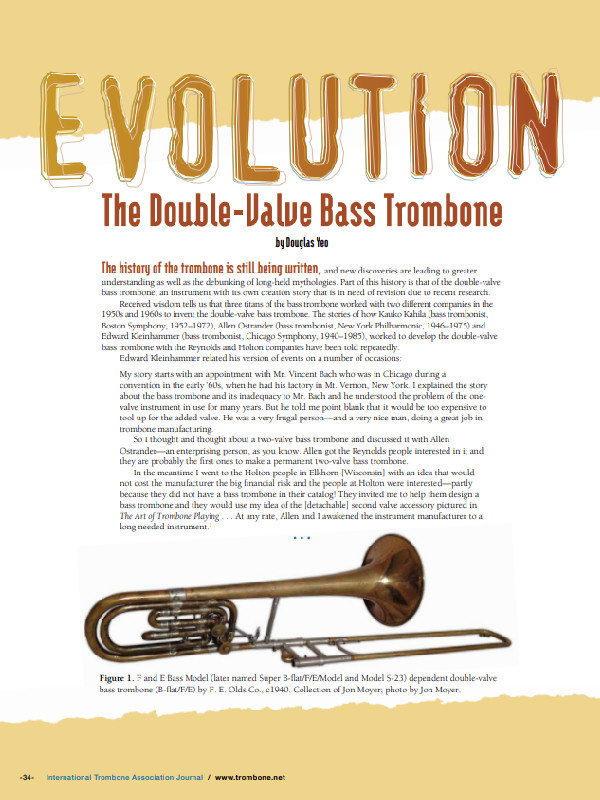
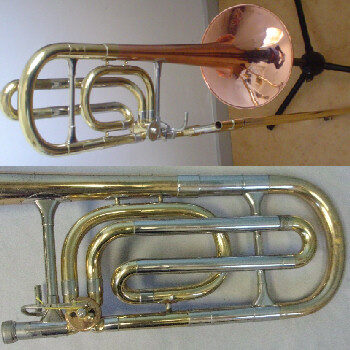
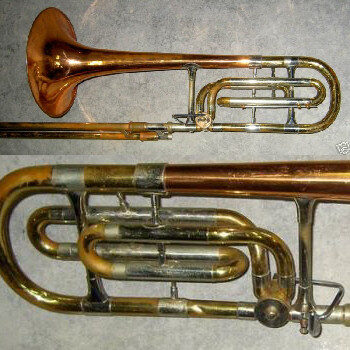

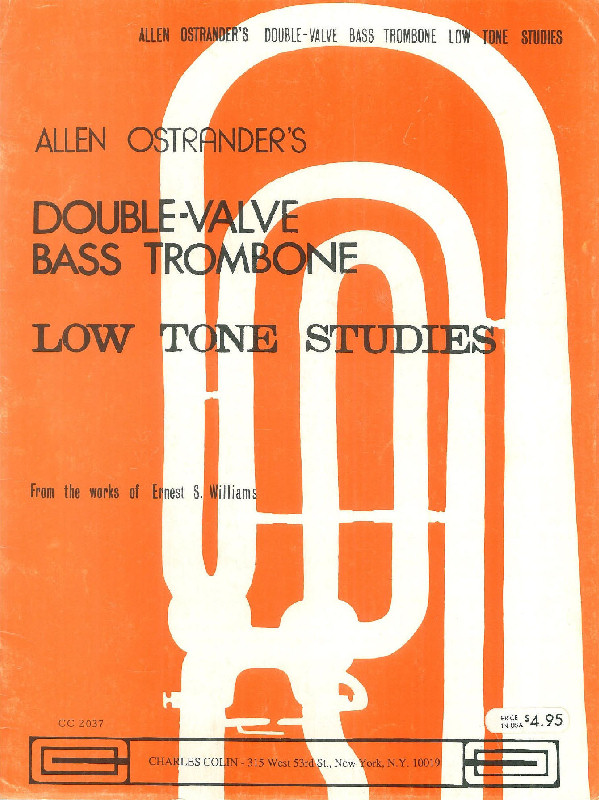
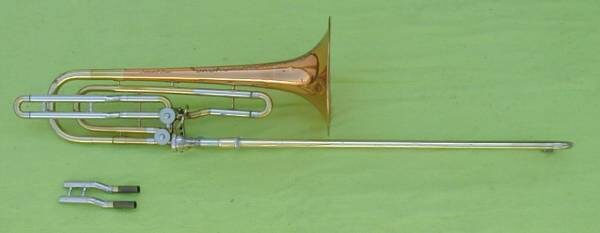


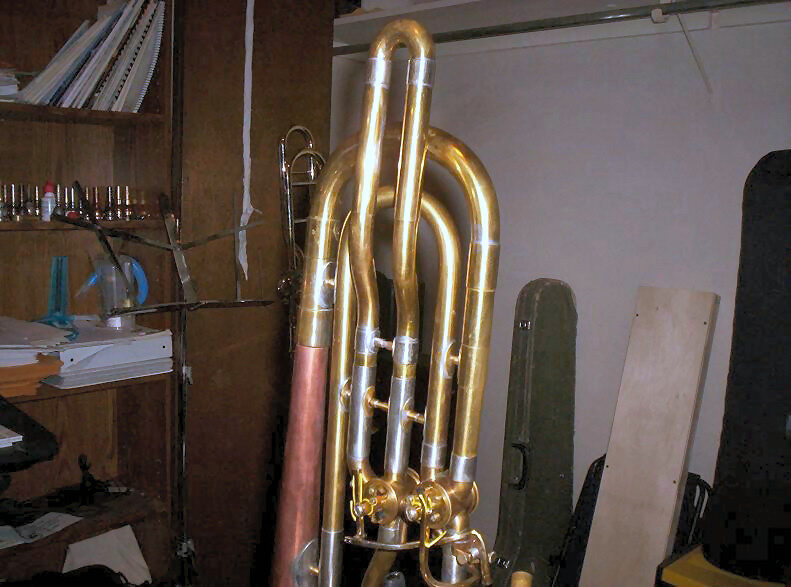
5 Comments
Join the discussion and tell us your opinion.
I have one of these Contempras: Single valve with E pull. Comments on this site about intonation are absolutely correct. I also have a King 4B Silver Sonic. The Contempra is far, far easier to play in tune. Period. It is almost like the pitches find me. I don’t have to find them. I use the Contempra for playing bass trombone and also 1st trombone parts. It works great!
I realized this after many A/B comparisons. This is an absolutely great horn. Very much under rated and under appreciated!
I owned a “Stereophonic” Reynolds bass a few years ago that had been modified by Dan Oberloh in Seattle, WA. It had a “D” slide patterned after a King “Duo Gravis” and had a split trigger. The workmanship was excellent. I traded it for a mint Conn 88H. I’d post pictures but see no way to do so. You did a fine job on overhauling the website !
I don’t know if this will help, but Scott Sweeney in Raleigh, NC fabricated a D crook for my Yamaha 612. Did a beautiful job, He plays bass trombone, so he really knows his stuff.
https://www.sweeneybrass.com/
Thank you for the tip. I do appreciate. George
I was wondering if anyone still manufactures the “D” extension for my Contempera “Stereophonic: bass bone. I wish to purchase a “D” extension for my horn.
Thank You,
George Paree